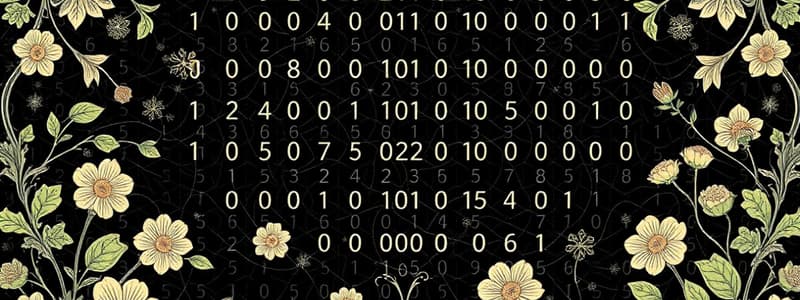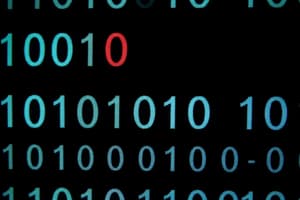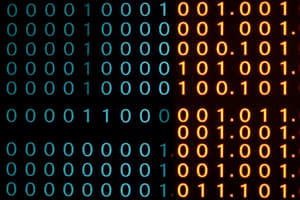Podcast
Questions and Answers
What is the result of converting the binary number 10100101 into One's Complement?
What is the result of converting the binary number 10100101 into One's Complement?
- -91
- -90 (correct)
- -87
- -89
In the Two's Complement method, what is the first step to convert a binary number?
In the Two's Complement method, what is the first step to convert a binary number?
- Convert it to decimal
- Take the One's Complement (correct)
- Add 2 to the binary value
- Leave the binary value unchanged
How many bits make up a byte in the binary system?
How many bits make up a byte in the binary system?
- 16
- 4
- 8 (correct)
- 32
What is the decimal value of the binary number 10100101 when viewed as a normal binary number?
What is the decimal value of the binary number 10100101 when viewed as a normal binary number?
What is the representation of the decimal number 687 in hexadecimal?
What is the representation of the decimal number 687 in hexadecimal?
Which prefix is used in binary to denote 1024 bytes?
Which prefix is used in binary to denote 1024 bytes?
What is the highest digit used in hexadecimal notation?
What is the highest digit used in hexadecimal notation?
When comparing binary and decimal prefixes, what does 1 KiloGram represent?
When comparing binary and decimal prefixes, what does 1 KiloGram represent?
What is the base of the decimal number system commonly used by humans?
What is the base of the decimal number system commonly used by humans?
Which digits are used in the binary number system?
Which digits are used in the binary number system?
How do you convert the binary number 01101110 to decimal?
How do you convert the binary number 01101110 to decimal?
In the context of binary representation, what does the leftmost digit indicate in One's Complement?
In the context of binary representation, what does the leftmost digit indicate in One's Complement?
When a binary number is in One's Complement form, how is the number 90 represented?
When a binary number is in One's Complement form, how is the number 90 represented?
What method is often used to represent negative binary numbers?
What method is often used to represent negative binary numbers?
What result do you obtain from converting the binary number 10100101 in One's Complement?
What result do you obtain from converting the binary number 10100101 in One's Complement?
What happens to the digits in the One's Complement method?
What happens to the digits in the One's Complement method?
What is the decimal equivalent of the hexadecimal number 2AF?
What is the decimal equivalent of the hexadecimal number 2AF?
What does Binary Coded Decimal (BCD) represent?
What does Binary Coded Decimal (BCD) represent?
Why do computers primarily understand the binary system?
Why do computers primarily understand the binary system?
What is the purpose of ASCII?
What is the purpose of ASCII?
What is the limitation of ASCII that led to the development of UNICODE?
What is the limitation of ASCII that led to the development of UNICODE?
How does UNICODE ensure compatibility with ASCII?
How does UNICODE ensure compatibility with ASCII?
What representation does UNICODE use for its additional symbols?
What representation does UNICODE use for its additional symbols?
Which of the following uses a 4-bit system to encode decimal digits?
Which of the following uses a 4-bit system to encode decimal digits?
Flashcards
One's Complement
One's Complement
A method of representing negative numbers in binary by inverting all the bits (0s become 1s and 1s become 0s) of the positive number and then adding 1. For example, the one's complement of 0101 is 1010.
Two's Complement
Two's Complement
A way of representing negative numbers in binary by inverting all the bits of the positive number and then adding 1 to the result. It is similar to one's complement but includes an extra step of adding 1.
Binary Prefixes
Binary Prefixes
A way of classifying the magnitude of binary numbers using prefixes like Kilo-, Mega-, Giga-, etc. These prefixes are based on powers of 2, similar to how the prefixes in the decimal system are based on powers of 10.
Hexadecimal
Hexadecimal
Signup and view all the flashcards
Binary Number System
Binary Number System
Signup and view all the flashcards
Positional Weight System
Positional Weight System
Signup and view all the flashcards
Binary to Decimal Conversion
Binary to Decimal Conversion
Signup and view all the flashcards
Sign Bit in One's Complement
Sign Bit in One's Complement
Signup and view all the flashcards
Sign Bit & Positional Value
Sign Bit & Positional Value
Signup and view all the flashcards
Decimal to Binary Conversion
Decimal to Binary Conversion
Signup and view all the flashcards
Hexadecimal to Decimal Conversion
Hexadecimal to Decimal Conversion
Signup and view all the flashcards
Binary Coded Decimal (BCD)
Binary Coded Decimal (BCD)
Signup and view all the flashcards
What is ASCII?
What is ASCII?
Signup and view all the flashcards
What is Unicode?
What is Unicode?
Signup and view all the flashcards
Why binary code is important?
Why binary code is important?
Signup and view all the flashcards
How does ASCII represent characters?
How does ASCII represent characters?
Signup and view all the flashcards
How does Unicode expand upon ASCII?
How does Unicode expand upon ASCII?
Signup and view all the flashcards
Why do we need ASCII and Unicode?
Why do we need ASCII and Unicode?
Signup and view all the flashcards
Study Notes
Data Representation
- Data representation in computers uses various systems including base 10 (decimal), base 2 (binary), and base 16 (hexadecimal).
- Humans are accustomed to base 10, using 10 digits (0-9).
- Binary (base 2) uses 2 digits (0 and 1).
- Hexadecimal (base 16) uses 16 digits (0-9 and A-F).
Binary and Prefixes
- In computing, a binary system is used. This system has only two digits, 0 and 1, and is often used to represent information and data.
- Binary numbers are represented by a series of 0s and 1s.
- Prefixes in binary systems denote magnitudes similarly to decimal systems, like kilobytes (KB), megabytes (MB), etc.
- The fundamental unit is a bit.
- 8 bits form a byte.
Hexadecimal
- The hexadecimal system uses base 16.
- It uses digits 0-9 and letters A-F.
- A conversion method from hexadecimal to decimal exists. The method involves multiplications by relevant powers of 16.
Binary Coded Decimal (BCD)
- BCD uses a 4-bit system to represent each digit in a decimal number.
- Each decimal digit is represented by a separate 4-bit code.
- This is useful for displaying decimal digits individually (like on a digital clock).
ASCII & Unicode
- ASCII (American Standard Code for Information Interchange) uses numerical codes to represent characters.
- It has 127 characters and symbols.
- Unicode is a larger system for encoding characters; it supports a wider range of characters. It includes representations for symbols from widely different languages and cultures.
Studying That Suits You
Use AI to generate personalized quizzes and flashcards to suit your learning preferences.




